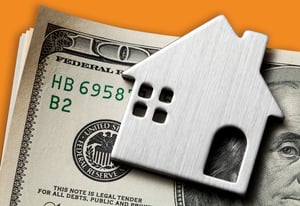Everything You Need to Know About a Home Equity Line of Credit
If you’re in Alabama and you’re looking for information on a Home Equity Line of Credit (also known as a HELOC) or a Home Equity Loan, you’re in the right spot.
Both a Home Equity Line of Credit and a Home Equity Loan allow you to take advantage of the equity you’ve built up in your home.
On this page, we’ll look at common reasons people in Alabama have for tapping into the equity in their homes, how a Home Equity Line of Credit works, the differences between a Home Equity Line of Credit and a Home Equity Loan, how to calculate the equity in your home, and, finally, how to get a Home Equity Line of Credit or a Home Equity Loan.
Common Reasons People Use a Home Equity Line of Credit
How Does a Home Equity Line of Credit Work?
Home Equity Line of Credit Versus a Home Equity Loan
Calculating the Equity in Your Home
How to Get a Home Equity Line of Credit or a Home Equity Loan
Common Reasons People Use a Home Equity Line of Credit
 There are many reasons you might seek a Home Equity Line of Credit ranging from debt consolidation to home improvement. Let’s take a look at a few.
There are many reasons you might seek a Home Equity Line of Credit ranging from debt consolidation to home improvement. Let’s take a look at a few.
To Make a Dream Come True
Maybe it’s time for the kitchen of your dreams. Perhaps you’ve been planning to update the master bath. Maybe you need to add-on to create a mother-in-law suite.
Whatever the case, a Home Equity Line of Credit allows you to borrow against the equity in your house to improve, update, or expand your house.
To Make Debt More Manageable
Do you have two or three credit cards with high interest rates? A Home Equity Line of Credit can allow you to borrow the money to pay off your credit card debt, in effect transferring the balance to a line of credit with a lower interest rate. Another huge plus is having a single payment instead of multiple credit card payments each month.
To Cover an Unexpected Expense.
Do you need a new furnace? A new air conditioner? A new roof? Are you facing a major medical expense?
Life throws us curve balls. It’s not fun, but it happens.
If you’re facing an unexpected major expense, a Home Equity Line of Credit may allow you to borrow the money you need to cover the expense instead of putting it on a credit card with a high interest rate.
To Create an Emergency Fund
Maybe you want to plan ahead. Is your house is getting older and you know things are going to stop working sooner than later?
An open line of credit would allow you to have available funds in case of emergency. That way, they’re already approved with a line of credit available to be drawn on, if and when it’s needed.
How Does a Home Equity Line of Credit Work?
Equity, Draws, and Repayment
Let’s start with defining “equity.” The equity you have in your home is equal to the appraised value of your home minus the amount you still owe on your mortgage. For instance, if your home is worth $200,000, and you still owe $120,000 on your mortgage, you have $80,000 in equity.
 Continuing with our example, a Home Equity Line of Credit would allow you to borrow against the $80,000 you have in equity. If approved, your line of credit would be determined based on the amount of equity you have and your creditworthiness. Your line of credit will have pre-determined “draw” (like “withdraw”) and repayment periods. Many lenders require an initial advance on your line of credit. Some will even waive your closing costs in certain circumstances.
Continuing with our example, a Home Equity Line of Credit would allow you to borrow against the $80,000 you have in equity. If approved, your line of credit would be determined based on the amount of equity you have and your creditworthiness. Your line of credit will have pre-determined “draw” (like “withdraw”) and repayment periods. Many lenders require an initial advance on your line of credit. Some will even waive your closing costs in certain circumstances.
During the draw period, the rest of the money is available when you need it, and your monthly payment is often an interest-only payment. When the draw period comes to an end, you begin paying back the outstanding balance plus interest, which brings us to our next topic. (Avadian’s HELOCs have a draw, or borrowing, period of 10 years followed by a repayment period of 10 years.)
Interest Rates
 First, the interest rates on Home Equity Lines of Credit are variable. Often your lender will offer an introductory interest rate for a set period of time (perhaps the first 12 months) after which the rate will be tied to the prime rate plus a pre-established margin.
First, the interest rates on Home Equity Lines of Credit are variable. Often your lender will offer an introductory interest rate for a set period of time (perhaps the first 12 months) after which the rate will be tied to the prime rate plus a pre-established margin.
What’s the prime rate you ask? Good question. The prime rate is a variable rate that moves as the Federal Reserve changes the federal funds rate. (The prime rate is not, however, the same as the federal funds rate. The prime rate the lender uses is often the one reported by The Wall Street Journal, based on a survey of the nation’s largest banks.)
The margin is usually a fixed percentage added to the prime rate to equal your interest rate. Your creditworthiness and the amount of equity you have in your home will impact the margin the lender charges you, and thus the interest rate you ultimately pay.
Typical Benefits of a Home Equity Line of Credit
- Lower rate than a fixed loan
- Interest-only payment options during draw period
- Ability to draw amount you want when you want (after an initial opening draw)
- Ability to borrow multiple times from the same line
- Lower closing costs
Home Equity Line of Credit Versus a Home Equity Loan
Home Equity Lines of Credit are similar to Home Equity Loans, but they do have some important differences. Both allow you to borrow money against the equity in your home. However, they differ when it comes to interest rates, how you receive the money, and how the monthly payments are structured.
| Home Equity Line of Credit | Home Equity Loan | |
| Interest Rate | Variable based on an index plus margin |
Fixed |
| Receive Borrowed Money | As needed during |
Entire borrowed amount at a single time |
| Monthly Payments | Interest-only during |
Principal plus interest throughout |
A Home Equity Loan might be preferable if you need a large sum of money up front for renovations or one-time expenses. A Home Equity Line of Credit might be preferable if you need access to money for an extended period of time beyond the initial draw but don’t want to pay interest on it if you end up not needing it (because plans do change, as we all know).
Calculating the Equity in Your Home
 Simply put, the equity in your home is the part of the house that is yours – and not the
Simply put, the equity in your home is the part of the house that is yours – and not the
NerdWallet offers an equity calculator that will determine your loan to value ratio and how much money you can expect to be approved for based on the value of your house, the balance of your mortgage, and your credit score.
How to Get a Home Equity Line of Credit or a Home Equity Loan in Alabama
If you’re ready to apply for a HELOC or a Home Equity Loan, you’ll want to decide on a lender. You’ll want to consider interest rates, term lengths, and draw periods. And, of course, you’ll want to think about the level of service you can expect from your lender.
The following may be required during the application process:
- Pay stubs
- W-2 forms
- Tax returns
- Homeownership records, such as a mortgage statement, homeowner’s insurance, and a tax bill
- Credit report
- Appraisal
Tax Benefits & Recent Changes to Tax Law
 You may have heard that Tax Cuts and Jobs Act of 2017 changed some of the laws regarding home equity lines of credit. This is true. Deducting interest from a HELOC was suspended from 2018 to 2026 unless “they are used to buy, build, or substantially improve the tax payer’s home that secures the loan.”
You may have heard that Tax Cuts and Jobs Act of 2017 changed some of the laws regarding home equity lines of credit. This is true. Deducting interest from a HELOC was suspended from 2018 to 2026 unless “they are used to buy, build, or substantially improve the tax payer’s home that secures the loan.”
From the IRS: “Under the new law, for example, interest on a home equity loan used to build an addition to an existing home is typically deductible, while interest on the same loan used to pay personal living expenses, such as credit card debts, is not.”
The law also requires that the loan be “be secured by the taxpayer’s main home or second home (known as a qualified residence), not exceed the cost of the home and meet other requirements.”
There are also new limits to the amount that can be deducted. Again, from the IRS site: “Beginning in 2018, taxpayers may only deduct interest on $750,000 of qualified residence loans. The limit is $375,000 for a married taxpayer filing a separate return. These are down from the prior limits of $1 million, or $500,000 for a married taxpayer filing a separate return. The limits apply to the combined amount of loans used to buy, build or substantially improve the taxpayer’s main home and second home.”
What’s Next?
We hope you’ve found this page to be informative and helpful. We at Avadian Credit Union are pleased to serve the people of Alabama.
If you are interested in learning more about Avadian, click here.
If you are interested in applying for a Home Equity Line of Credit or Home Equity Loan, please click here and fill out the form to get started today. Or call us at 1.888.
The credit union is federally insured by the National Credit Union Administration.
Additional insurance of up to $250,000 on your savings accounts is provided by Excess Share Insurance Corporation, a licensed insurance company.
![]() Equal Housing Opportunity Lender. Copyright © 2020 Avadian Credit Union. All rights reserved.
Equal Housing Opportunity Lender. Copyright © 2020 Avadian Credit Union. All rights reserved.

